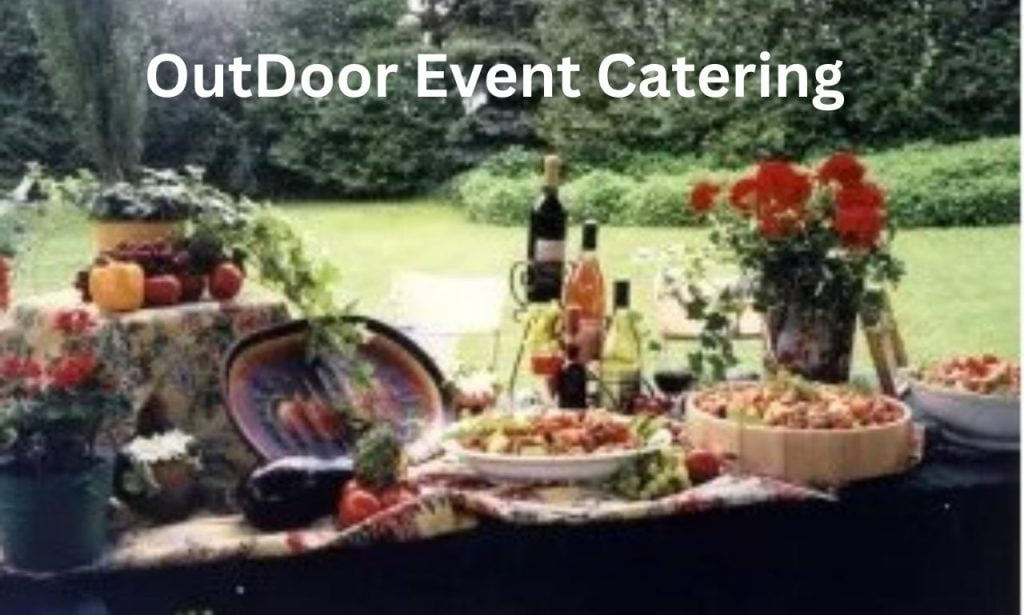Catering for outdoor events comes with its own set of unique challenges and opportunities. Unlike indoor events, outdoor catering requires detailed planning and the flexibility to adapt to changing weather and environmental conditions. Events such as casual picnics, elegant weddings, or large corporate gatherings each have specific needs that must be addressed to ensure a smooth operation.
Factors like weather, venue layout, and accessibility play a crucial role in the planning process. Additionally, maintaining food safety and hygiene standards is more complex outdoors. Ultimately, a customized approach is necessary to provide a perfect and enjoyable experience for all guests.
What is an Outdoor Catering?
Outdoor catering refers to the provision of food and beverage services at events held in outdoor settings, such as gardens, parks, beaches, or other open-air venues. This type of catering requires careful planning and logistics to accommodate various environmental factors, including weather conditions and location accessibility.
Outdoor caterers must be equipped to handle the unique challenges that come with serving food outside, such as maintaining proper food temperatures and guaranteeing hygiene standards. The goal of outdoor catering is to provide a perfect dining experience that enhances the overall ambiance and enjoyment of the event. Whether it’s a casual picnic, a formal wedding, or a corporate retreat, outdoor catering plays an important role in the success of the occasion.
Book Now: Corporate Lunch Catering San Francisco
The Comprehensive Guide for Outdoor Event Catering
If you are planning an outdoor catering event, here is a step-by-step guide for organizing a perfect gathering.
Initial Planning and Considerations for Catering Outside
The foundation of successful outdoor catering lies in thorough initial planning. Start by understanding the type of event and the audience you’ll be serving. Are you catering for a casual family reunion, a formal wedding, or a corporate retreat? Each type of event will have different requirements and expectations.
Next, establish a clear budget to guide your decisions on menu options, staffing, and equipment. Don’t forget to secure the necessary permits and licenses for outdoor food service, as regulations can vary widely depending on the location. Finally, consider the logistical aspects such as transportation, setup, and teardown to ensure all elements align with the event’s goals.
Related: Corporate Lunch Catering Napa County
Venue Selection for Catering for Outdoor Events
Choosing the right location is important for a successful outdoor event. The venue should align with the event’s theme and size and also should offer ample space for guests to move around comfortably. Accessibility is another key factor, also guarantee that the location is easily reachable for guests and your catering team. Also, weather considerations are paramount, have a contingency plan in place for rain or extreme heat, such as tents or indoor alternatives.
Additionally, check for amenities like restrooms, water sources, and power supplies, which are essential for both the guests’ comfort and the catering operation.
Get now: Corporate Lunch Catering Santa Cruz County
Outside Catering Menu Planning
A well-planned menu can enhance the environment of the entire event. Start by customizing the menu to suit the event type and audience preferences. For a casual event, consider offering a variety of finger foods and easy-to-eat dishes, while a formal event may require a more sophisticated selection.
Always take dietary restrictions and preferences into account, offering vegetarian, vegan, and gluten-free options. Utilize seasonal and locally sourced ingredients to ensure freshness and support local producers. Finally, consider the logistics of preparing and serving food outdoors, opting for dishes that can be maintained at safe temperatures.
Read More: Corporate Lunch Catering Almeda County
Event Equipment Setup
The right equipment is essential for smooth outdoor catering. Essential items include portable grills, chafing dishes, coolers, and food storage containers. Plan the layout of cooking and serving stations to optimize workflow and guest access. Also make sure you have reliable power sources, whether through generators or access to electrical outlets, to run cooking equipment and lighting.
Lighting is particularly important for evening events, enhancing both functionality and ambiance. Don’t forget to bring sufficient tables, chairs, and serving ware to accommodate all guests comfortably.
Food Safety and Hygiene for Catering Set Up
Maintaining food safety and hygiene is very crucial in an outdoor setting. Likewise, guarantee that all food is kept at appropriate temperatures, using coolers for cold items and insulated containers or portable heaters for hot dishes. Establish a strict sanitation routine, with handwashing stations and sanitizing supplies readily available.
Also, adhere to local food safety regulations and best practices to prevent contamination. Safe food handling procedures, such as proper cooking temperatures and avoiding cross-contamination, are essential to protect your guests’ health and your reputation.
Outdoor Event Staffing and Coordination
Adequate staffing is key to a successful outdoor catering event. Determine the number of staff needed based on the event size and complexity, including chefs, servers, and support personnel. Train your staff specifically for outdoor events, emphasizing flexibility and quick problem-solving skills.
Coordination with other vendors, such as event planners, rental companies, and entertainers, is important to ensure all aspects of the event run smoothly. Clear communication and detailed timelines will help avoid last-minute surprises and ensure a cohesive guest experience.
Catering Beverage Services
Beverage service can greatly enhance an outdoor event, that’s why select beverages that complement the menu and suit the event’s atmosphere, such as refreshing cocktails for summer parties or warm drinks for cooler evenings.
Also, setting up dedicated beverage stations or bars can streamline service and reduce wait times. Similarly, make sure you have the necessary permits for serving alcohol and that staff are trained in responsible service practices. Consider offering non-alcoholic options and specialty drinks to cater to all guests’ preferences.
Entertainment and Atmosphere
Creating a pleasant atmosphere is vital for the success of an outdoor event. Enhance the guest experience with appropriate music and entertainment that go well with the event’s theme. Whether it’s live music, a DJ, or ambient background tunes, sound can significantly impact the event’s mood.
Additionally, pay attention to the overall aesthetics, including decorations, lighting, and seating arrangements. Comfortable and visually appealing setups encourage guests to relax and enjoy the event. Interactive elements like photo booths or lawn games can also add a fun and engaging touch.
Managing Challenges of the Outdoor Event Catering
Outdoor events are inherently unpredictable, so being prepared to manage challenges is essential. Weather issues are a common concern; always have a backup plan such as tents or an indoor alternative. Flexibility is key when dealing with last-minute changes, whether it’s a sudden change in guest count or a shift in schedule.
Effective communication with your team and clients can help mitigate stress and guarantee everyone is on the same page. Ultimately, the goal is to confirm guest satisfaction by being proactive and adaptable, addressing any issues promptly and professionally.
Post-Event Wrap-Up
The work doesn’t end when the event does; a thorough post-event wrap-up is crucial. Efficient cleanup and waste disposal are essential to leave the venue in good condition and maintain a positive reputation. Gathering feedback from clients and guests provides valuable insights into what worked well and what could be improved.
At the end, conduct a detailed review of the event with your team, identifying strengths and areas for improvement. This continuous learning process helps refine your catering services and prepares you for future outdoor events.
NutriGastro for Outdoor Catering Services
For those planning the best catering for outdoor event in San Francisco, NutriGastro offers top-tier catering services tailored to meet your unique needs. With years of experience in the industry, NutriGastro stands out as one of the finest catering options for outdoor events, specializing in creating memorable culinary experiences for both casual gatherings and formal celebrations.
As expert outside caterers, their skilled professionals handle everything from menu planning to setup and cleanup for an effortless and stress-free event. You can trust NutriGastro to provide delicious, high-quality food and exceptional service, making your outdoor event a resounding success.
FAQs
What food is good for outdoor catering?
For outdoor catering, opt for foods that are easy to serve and eat, such as finger foods, sandwiches, and wraps. Grilled items like skewers, burgers, and hot dogs are popular choices due to their convenience and appeal. Salads, both leafy and pasta varieties, are great for warm weather and can be prepared in advance. Additionally, consider offering refreshing beverages and desserts like fruit platters and cookies to complete the menu.
How to make catering look nice?
Displaying bites, small plates, and family-style dishes on your table calls for a touch of creativity. Consider using non-traditional serviceware to add a unique flair. Alternatively, disposable textiles like butcher’s paper can offer a practical and stylish solution. Keep in mind the flow of service, the customer’s vision, and the optimal presentation for easy maneuverability. This thoughtful approach ensures that the food is both visually appealing and accessible to guests.
What is the easiest food to cater?
Pasta dishes, such as spaghetti and meatballs or lasagna, are ideal for buffet-style meals because they are easy to prepare in large quantities and can serve many guests. Similarly, salads are a great choice due to their cost-effectiveness and ability to cater to a large crowd.
What is the purpose of outdoor dining?
Adding outdoor dining allows you to accommodate more customers than with indoor seating alone. Improved foot traffic is another benefit; if your restaurant is located in a busy area, an outdoor dining space can attract passersby. This is especially advantageous during the spring and cool summer months when outdoor dining is particularly appealing.
Conclusion
Catering for outdoor events involves detailed planning, adaptability, and attention to detail for a perfect and memorable experience for guests. From initial preparations and venue selection to menu planning and handling unexpected challenges, every aspect must be carefully considered. Prioritizing food safety and hygiene, along with effective coordination and staffing, is essential for smooth operations.
By focusing on creating a pleasant atmosphere and providing high-quality food and service, outdoor caterers can elevate any event. Whether it’s a casual gathering or a formal celebration, following this comprehensive guide will help you achieve success in outdoor catering.





